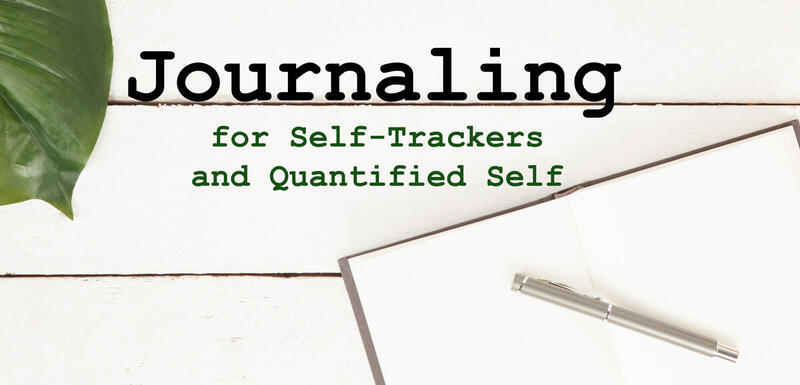
Journaling is a great exercise for your mind. It can help you deal with emotions, record a memory, capture a lingering thought, or clear your mind for the real work of your day. Writing a journal is a highly recommended habit for artists, entrepreneurs and pretty much anyone. It is also a great way to start your day. According to several research studies, regular journaling can even make your happier and more productive.
At its most basic, journaling is the act of spending some time to write something. Journaling is moment to write anything.
For self-trackers and quantified self enthusiasts, journaling also offers an opportunity to capture some personal data too. Depending on the tool you use (more on this later), when you create an entry, you also collect various metadata on that moment like date, time, location and even the weather. You could also note your mood too. These data points can be used for data analysis and data visualization.
Along with the metadata, when you journal, you are creating a piece of text. You have the word count and frequency of word usage. This text and its words can be analyzed with more sophisticated data processing techniques. For example, natural language processing (NLP) is a branch of machine learning and artificial intelligence that is capable of gathering statistics, deriving meaning, building models and understanding the sentiment of the text.
Furthermore, if you looking to build a positive habit into the start or end of your day, then journalling is one of the best. For example, you can use a few minutes of journaling at the beginning of the day to prepare your mind and feelings. This is often referred to as “morning pages,” and this is how I journal.
You can also use journalling at the end of the day as a way to express what you did, how it went and project plans for the day to come. This kind of journaling can be a great way to close out your day and building positive feelings too.
There are tons of ways you can journal. Some people like keeping a diary of events and memories. Others like journaling while traveling or keeping a log of their children’s lives. The format of journaling is wide open and highly individualized.
In this post, I want to look briefly at journaling with a particular focus on how it can be used for self-tracking. We will look at the benefits of journaling, various tools you can use to capture your words, and how you can capture and use data you can get.
Why Journal?
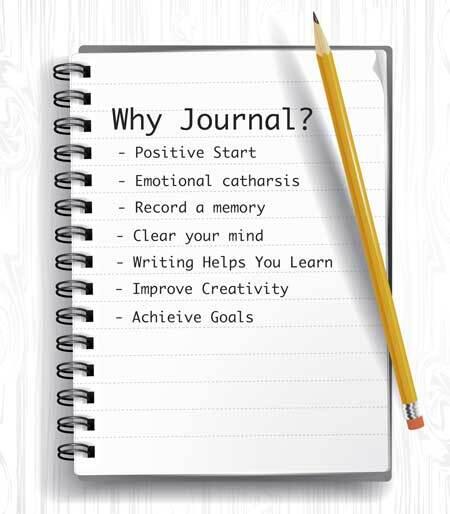
Personally, journaling is one of my favorite habits, and I consider it one of my cornerstone habits. I’ve journaled in different ways in my life, including travel journals and even a “Language Diary,” which I wrote exclusively in French while learning the language and living in Paris.
Currently the most common way I journal is “Morning Pages.” Before I jump into my email inbox or start on my task list, each morning morning I start with journaling. Most days I spend about 5 minutes, and I write about an idea I had or a situation I want to express in words. This helps me clear my brain and focus on whatever is next.
What are some of the benefits of journaling?
- Positive Start Your Day: Several studies have shown that journaling has positive benefits to your mood and can affect how you start your day.
- Emotional catharsis: Journaling has been shown by at least one study to help people deal with emotions by externalizing it and put it in words on the page.
- Record a memory or lingering thought: Keeping a diary or journal provides you with an interest memento about your life. It’s also how we typically imagine journaling too.
- Writing Helps You Learn: Journaling like blogging or other types of writing is a good way to take what you are learning and put it into more long term memories. For example, a journal can be your way of reexpressing some element of your learning in other areas of your life.
- Clear your mind for more focused work: Journaling is considered a well-known life hack to help you take an issue that is bugging you and put it on the page in some form. This taking action with words will allow you to move onto whatever else you need too.
- Happier and more productive: Journaling is thought to make people both happier and more productive, and a few studies have displayed the benefits of regularly keeping a journal.
- Put It in Words to Reach Your Goals: While action trumps planning, a journal about a project or goal can help you achieve your goals and projects. Journaling can provide space for the back-and-forth and help you eventually get where you want to go.
- Improves Creativity: Journaling can help you get started on a creative project. By journaling you build muscles that can help you think through ideas on lateral projects and is known help writers, artists and thinkers be more creative.
Tools for Journaling and Notes
There are lot of options when it comes to journaling. You can record your thoughts on a digital device or on physical paper. Essentially any note taking app software can be used to keep a journal.
Here are a few I like (as of Dec 2017):
- Evernote: Evernote is the granddaddy of note taking software. Lots of features, syncs across devices, and integrates with lots of other services.
- SimpleNote: SimpleNote is a plaintext app that you can use on your computer, in an app or on the web. Simple and effective with various export options.
- OneNote: This is Microsoft’s alternative to Evernote, and feature-to-feature, it provides much of what you expect from a note taking app. It’s cheaper than Evernote.
- Day One: Day One can be a note taking app, but unlike the others, it is best described as a true journaling app. Minimalist interface and plaintext editor with good integration with photos.
Here is an updated list of my preferred note-taking and journaling app (as of June 2023):
- Typora - a simple, well-design markdown text editor with embedded images.
- The Archive - a simple markdown text editor with advanced features for tagging and organization, built for knowledge management using Zettelkasten Method.
For a full write-up and breakdown on my note-taking tech and processes, checkout out my post, The Plain Text Life: Note Taking, Writing and Life Organization Using Plain Text Files.
All of these tools are great choices for journaling, and your choice will be one of personally preference.
I’ve used Evernote for over a year for my daily morning journaling. Evernote is my preferred tool for capture all of my writing and text, so it was an obvious choice. My personal “hack” was integrating IFTTT with the RSS Quote Feed from Brainy Quote so each day a template entry with a quote and a few prompts is added to Evernote for me.
I recently switched from Evernote to using Day One for my morning journal. Besides its cleaner design and UI, Day One is better at capturing additional metadata and provides a better export option for data analysis.
Day One: My Preferred Journaling Tool for Self-Trackers
Unlike Evernote, OneNote or SimpleNote, Day One positions itself as a journaling and diary application. Its interface is cleaner and more focused on writing. Unlike Evernote, Day One is more single focused on journaling.
Here is the listing display of entries:
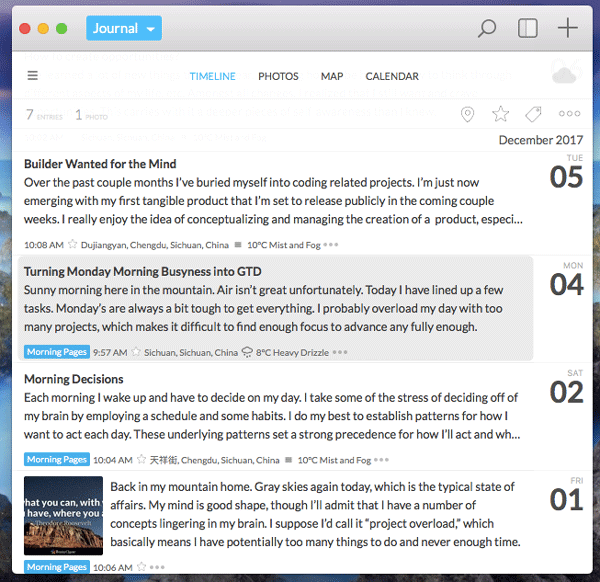
Day One’s UI is minimalist when it comes to writing an entry. It has a few listing options including the reverse chronological preview mode, a calendar, map and even a photo gallery.
Under the hood of its clean interface, Day One has a very clean data model. What you write is in pure plain text with minimal markup.
The application also has a couple of useful additions for adding tracking. When you add an entry, the app stores a a few additional metrics like location, time of day and even weather. These extra metrics adds some nice advantage for journaling self-trackers too, since not only are you journaling but you have several data points for putting your journaling in perspective through the data.
Exporting Your Writing and Data from Day One
Day One’s data is also easily accessible and exportable.
With Day One, you can export your journal entries in several formats: PDF, HTML, Plain Text and JSON. These kind of export options makes it easy to move your journal entries into other tools, if you want to store your writing somewhere else or if one day you’d like to move to a different service.
The advantage of exporting your data in JSON is that you get well-formatted data like this:
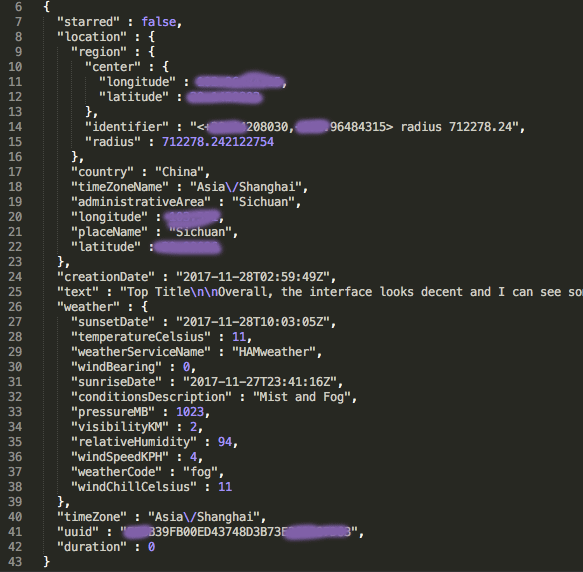
JSON is a great export option, and you can use other tools like Zenobase or Tableau to do data analysis and data visualization. Moreover, you can leverage more sophisticated data processing languages and tools to explore your journal writing too.
The only export option I would add here would be CSV or Excel. Fortunately, JSON can be converted in CSV if you prefer to manage it in a spreadsheet application.
Tips for Keeping a Journal
Here are my tips for keeping a journal.
Tip #1: Make It a Habit
When it comes to any activity, consistency is the most important. If you want to mediate, do it often. If you want to run faster, train regularly. So if you want to write or get some of the benefits of journaling and writing, it needs to become a habit.
The topic of creating and managing your habits goes beyond this post, but the key idea is to schedule your journaling habit and stick to that schedule. Come up with a good trigger for when you will journal. For example, I write my morning pages as the first act I do on my computer each day.
Tip #2: Set a Daily Reminder to Journal
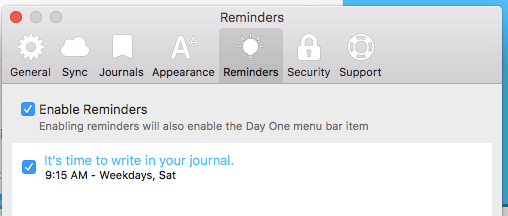
Once something becomes a habit, you rarely need the reminders. But when you are just getting started, reminders can help. DayOne includes a feature to remind you to do your journaling. It’s configurable for the time and even auto-tag the entry.
I’m a big fan of these automatic notifications. In order to avoid getting sucked into email and social media, several years ago I added a reminder and focused time block with RescueTime. When I first start using my computer in the morning, RescueTime goes into “Focused Time” mode and blocks various websites. I get a notification and receive a Daily Quote from BrainyQuote.com.
So, instead of instantly checking my email, I’m nudged to do something better like journal or read an article or book. My day doesn’t start with email or tasks but instead I read, write and reflect.
Tip #3: Automatically Add Social Media Photos to Your Journal
IFTTT is a free automation service that lets you connect different tools and services you use together. When an event happens in one service, it can trigger an action in another. You can create lots of different “recipes” to automate your life. One of the most powerful aspects of Evernote is how easily it can be integrated with dozens of other services.
Day One does not integrate as fully with IFTTT as Evernote. Specifically you don’t have any triggers. So you can cannot repost a note in Day One as easily to other services. That said, it is easy to use other services to post entries into Day One. One of my favorite is reposting photos from social media into my journal.
Like journaling, Daily Photos is another habit that can promote positive energies, a good mood and even productivity. For more on this idea, check out my post, Documenting a Life, One Photo at a Time.
Having photos with your journaling can create an added layer for your reflections and writings. It also creates a nice product too when you can see photos and words together.
Tip #4: Go with the Flow
Unlike the structure of our tasks, habits or even self-tracking, journaling doesn’t need to be quite so formal. Just take some time to write and reflect. In fact, journaling might best be thought of as free form reflections.
When you open your paper or digital journal, pick an idea, thought or question and write. Using your journal as a way to get out of the analytical mind and into the connective, creative and exploratory mood.
To put it another way, Find a Topic that Pulls You, Then Just Write.
Alternatively there a lot of good services out there that can help you find prompts on things to write about or reflection topics to explore.
Conclusion: Journaling for Self-Trackers and Quantified Self Enthusiasts
![]()
In this post, we looked journaling and at several tools you can use to capture your journaling words, before concluding that Day One is one of best journaling application if you want to also have access to your data.
Personally, I’m surprised how few people journal. Keeping a journal might seem like a Victorian era luxury, but I find journaling to be one of the best habits I leverage to start my day. My Morning Pages help me clear my thoughts, capture an idea or just warn up my fingers and brain.
Overall, I believe journaling is a great habit for healthy and happy human beings. There are number benefits for your mind and spirit as well as just a positive thing to do. For self-trackers, your morning pages present an opportunity to log some data at a routine time each day. Like measuring your Heart Rate Variability to check your stress levels, your morning pages can be a measure of your mood and what’s on your mind.
Once I’ve looked at the data more, I hope to share more on how this data point can be better integrated into a quantified life.
The important thing to remember about using Day One for journaling and self tracking is two-fold: 1. Day One provides a clean and nice interface that makes it really easy and enjoyable to write. 2. Along with passively tracking a bit of extra meta data, Day One’s exports are well-structured and portable, which means you can move, visualize and analyze your data.
When we use different productivity and technology tools, the first thing we think about is its functionality. Can the tool help me do something and hopefully do it in less time and more easily? Is the app providing me a function I need?
When you get beyond just the function, the second consideration I make on the tools I use is around data and data accessibility. Does this tool do anything interesting with my usage data? Does the provide me an easy way to get my data? Can I export it, manipulate it or integrate it with other tools? Is the data meaningful, accessible and portable?
There are several reasons why I prioritize data accessible with the tools I use. Getting my data makes me more comfortable that I’m not “locked” into that product. I can change tools but continue to have the same data there.
Having access to my data also provides an opportunity for data analysis and data visualization. For example, I use my data to understand aspects of my life, like my Book Reading Patter. While on-going, I use my data to make on-going and data-informed changes about my health, productivity and even creativity.
When it comes to written language, you have a special kind of data, namely language and words. It isn’t pure numbers and counts. This is a challenge and opportunity. Natural Language Processing and more sophisticated data analysis and modeling are outside the scope of this post, but it is an amazing field in and of itself and an area I hope to share more on as I spend time parsing, processing and analyzing my writing.
If you found any ideas interesting or want to share your use case, give me comment below. Good luck with your writing, journaling, and tracking!
